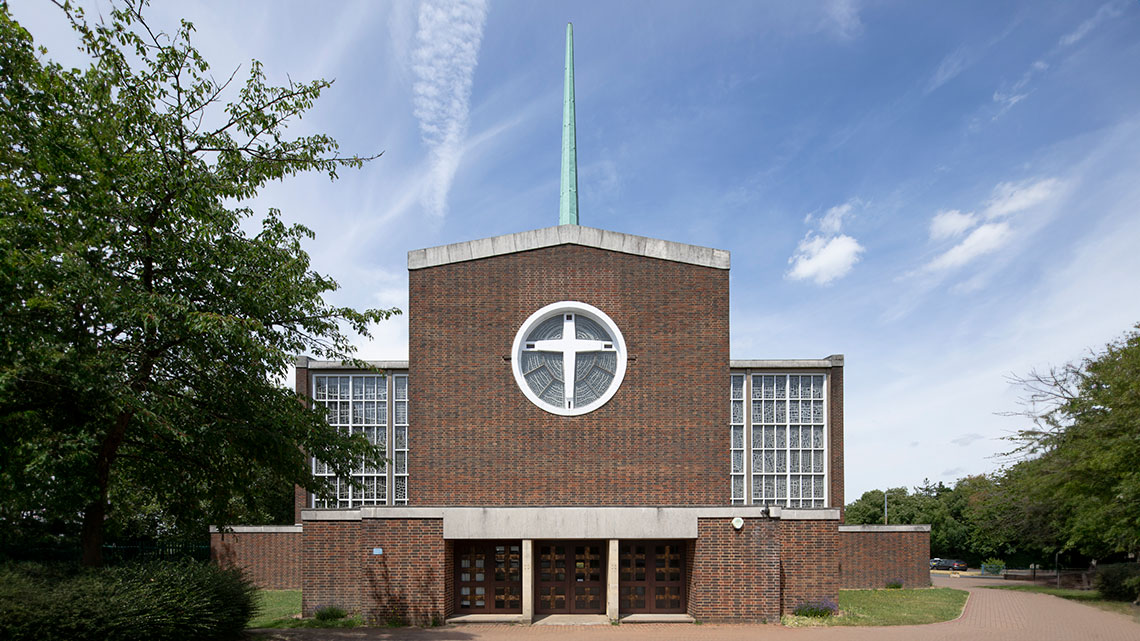
A Catholic Church in the Diocese of Brentwood, Our Lady of Fatima in Harlow, has been upgraded to Grade II* (star) by the Department for Culture, Media and Sport on the advice of Historic England.
The church was designed in 1953-1954 by Gerard Goalen (1918-1999), one of the most important British architects of the Catholic Modernist movement, in his first ecclesiastical commission.
Goalen was recommended as the parish church’s designer by Sir Frederick Gibberd (1908-1990), who was masterplanner and chief architect of Harlow New Town. At the time, Goalen was working with Gibberd, designing factories for the town’s industrial estates.
He studied at the Liverpool School of Architecture and briefly worked for Francis Xavier Velarde (1897-1960), a major Catholic church architect of the inter-war and post-war periods.
His passion for modern church architecture was shared by Francis Burgess, parish priest of Harlow New Town. The Church of Our Lady of Fatima was one of the earliest liturgically inspired churches to be planned in England.
The design brief, highly innovative for 1953, was for a church capable of holding up to 500 people, with a freestanding altar in the middle of the congregation, clearly visible to all.
The church was built in 1958-60 in a prominent urban location, helping to create the civic identity of the New Town of Harlow. Goalen’s church provided the Catholic community with a space that connected their new modern social and physical environment with their religious lives.
The church was built in a striking modernist style, using reinforced concrete and Surrey stock bricks, with a distinctive T-shaped plan, central needle spire and simple colour scheme.
Stunning dalle de verre glass panels (a glass art technique using thick pieces of coloured glass, giving a deep colour effect) cover around sixty percent of the wall surfaces, bathing the church in glorious colour and light.
These vibrant glass designs, depicting the Joyful Mysteries of the Rosary along with the Tree of Jesse and the Apparitions of the Blessed Virgin Mary at Fatima in 1917, were created by Benedictine Monk Dom Charles Norris of Buckfast Abbey, one of the most influential and prodigious glass artists of the 20th century. This was the first of some 250 schemes he undertook in the dalle de verre technique across the United Kingdom.
The church was opened and blessed by the Bishop of Brentwood on 26 March 1960.
By the time work had commenced on Our Lady of Fatima, Goalen had joined Frederick Gibberd’s practice and, in 1959, submitted a competition entry to design Liverpool Metropolitan Cathedral. The competition was won by Gibberd himself despite his lack of church building experience or strong religious convictions. His last-minute entry is said to have been influenced by his attendance at Our Lady of Fatima’s opening Mass.
Goalen subsequently established his own practice, designing churches such as St Gregory the Great, South Ruislip (1965-67), St Thomas More, Swiss Cottage (1968), both listed at Grade II, and the Catholic Chaplaincy in Cambridge (1977).
Music fans will recognise the Church of Our Lady of Fatima from the album cover for The Chemical Brothers’ 1998 album, Brothers Gonna Work It Out.
Originally listed at Grade II in December 2000, the church has been upgraded to Grade II *(star) listing to reflect its historic and architectural significance.
The Rt Reverend Alan Williams sm, Bishop of Brentwood, said:
“I am very happy to know that Our Lady of Fatima Church in Harlow has been upgraded to Grade II* listing. It is an important church architecturally, not just in the Diocese but nationally. It was one of the first of its kind and unique for its stained glass.”
Duncan Wilson, Historic England Chief Executive, said:
“This stunning church was created as part of the new town of Harlow, offering a brighter and better future in the post-war years, and has been at the heart of the community ever since. With its modern style, striking spire and glorious glass panels, it has proved an inspiration in contemporary church design and is loved by people who take comfort in its calming, beautiful presence every day.”
Clare Price, Head of Casework at C20 Society commented:
“As a pioneer of a unified scheme of dalle-de-verre glass and modern design, C20 Society is delighted that Our Lady of Fatima has received the Grade II* listing it rightly deserves. The effect on walking into the church is uplifting, the feeling of entering a shifting kaleidoscope of colour coupled with the radical new liturgical arrangement of the interior must surely have made many a new town worshipper gasp in astonishment. It has lost nothing of its impact in the intervening years, the interior being of such stunning jewel-like quality that it was chosen as the front cover illustration for our book 100 Churches 100 Years, while the exterior was even featured on the cover of a Chemical brothers album!”